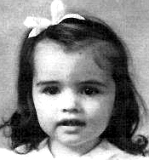 Missing from: Carolina Beach, North Carolina
Missing from: Carolina Beach, North Carolina
Missing: May 10, 1941
Age at disappearance: 4
Hair: Dark hair
Distinguishing Characteristics: Scars, Marks, Tattoos: Caucasian Female Child
Details of Disappearance: Four-year-old Mary Rachel Bryan and her mother Leila Lewis Bryan were last seen on May 10, 1941.
Investigative Agency: N.C. State Bureau of Investigation at (704) 377-9200
If you have any information on this case, please contact CUE Center for Missing Persons at (910) 343-1131 or call the CUE Center 24-hour tip line at (910) 232-1687. All information submitted to CUE Center for Missing Persons is confidential.
Lelia Lewis Bryan
Missing since: 05/10/41
Missing from: Carolina Beach, North Carolina
Classification: Endangered Missing
Age at disappearance: 36 years old
Height: 5’7″, Weight: 120-125 lbs.
Caucasian Female
Hair: Dark, Eyes: Dark
Clothing: A summer print dress, brown and white shoes, and a green turban.
A native of Bladenboro, Leila and her husband, E.C. “Eddie” Bryan, lived at Carolina Beach. The couple worked for the Atlantic Coast Line Railroad. Leila had been enrolled in nursing school when the couple became engaged and were married. Bryan got her an office job at the railroad. Leila’s mother disapproved of the marriage, as Eddie was divorced. The weekend she disappeared, Mary Rachel and Leila were headed for Bladenboro to visit her family. Because of the enmity between her husband and mother, Eddie wasn’t accompanying Leila and Mary Rachel. She planned to leave either Friday or Saturday, possibly riding with her brother, Berry Lewis. Mary Rachel’s Sunday shoes were polished, and several rings Leila always wore were found at the Raleigh Street home. The rings were Leila’s favorites, and she rarely left home without them, according to friends.
On May 10, 1941, Eddie Bryan told investigators that Leila said she was driving to a store a few blocks from their home. Bryan later told investigators that Mary Rachel asked to ride along. At Carolina Beach at the time, according to town records, there was a small grocery store catering to fishermen and vacationers, a store similar to a general store, and a combination grocery/ department store. All three of the stores were in the same general area, near the modern intersection of U.S. 421 and Channel Drive. Where Leila went shopping that evening, if she did, has never been discovered.
Berry Lewis went to Carolina Beach to visit his sister around 9 p.m. on May 10, 1941. Lewis awakened Bryan, who told his brother-in-law that Leila had gone to the store. Lewis apparently drove around the beach for an hour or so, looking for Leila and Mary Rachel. Figuring he must have somehow missed them, he returned to the Bryan home, located in the 200 block of North Raleigh Avenue. Leila Bryan’s 1935 Ford coupe was still missing. Husband, brother, or both called police.
Bryan told police he was making concrete forms in the couple’s garage when Leila had come home around 6:30 p.m. and made supper. Leila and Mary Rachel had spent the afternoon on the beach. Local attention was intense as well-Leila’s family was well-liked and widely known in the Bladenboro area. Searchers were combing the island and the surrounding areas for any clue of Leila, Mary Rachel, or the Ford coupe. Professional divers searched areas where a car could be driven into the Cape Fear River, Snow’s Cut, and the Intracoastal Waterway. Officers visited gas stations from 50 to 100 miles away, since Eddie Bryan told investigators he didn’t think the Ford had more than half tank of gasoline when Leila left.
At the request of a newspaper, officers in Pinellas , Florida, began searching for the woman when the pair was reported spotted nearby. Officers questioned some of Eddie Bryan’s family who lived in the area, but no clues were located. Stories and advertisements were placed in newspapers across the country as leads and suspected sightings were checked and rechecked.
Officers thought they had a break later that summer when someone found a piece of automobile windshield in Snow’s Cut (a large canal connecting the Cape Fear River and the Intracoastal Waterway north of Carolina Beach). It was just a few feet offshore, out from a little beach. It was in maybe 18 inches of water at the outside, and had been there for a while. Investigators determined the glass could have come from a 1935 Ford, but couldn’t be sure. The windshield fragment was sent to the SBI lab in Raleigh, but as the case grew cold over the years, the glass disappeared.
Investigators examined three possible fates of Leila and Mary Rachel: Leila could have committed suicide, taking her daughter with her, by driving into the Waterway, the Cape Fear River or off Snow’s Cut; Leila could have run away, hiding her own and Mary Rachel’s identities to escape what some reported was an unhappy marriage; or, the woman and child were murdered, and their bodies hidden, and the car dismantled or destroyed. Investigators never found sufficient evidence to suggest anyone killed Leila and Mary Rachel. No one was ever charged. Nor was there an indication by friends or family that she had ever considered suicide. Neither mother nor child was ever seen again.
Related News Articles
DIGGING FOR 67-YEAR-OLD REMAINS YIELDS ONLY DIRT
The disappearance of Leila Lewis Bryan, 36, and her 4-year-old daughter Mary Rachel in 1941 was never solved. Today the SBI cut into the concrete floor of their former home in Carolina Beach to see whether images captured by geological surveying equipment were their remains. Lewis Smith arrived at the little cream-colored house surrounded by palm trees on Raleigh Street Tuesday morning before the officials from the State Bureau of Investigation.
It was the day a 67-year-old unsolved mystery was put to rest for Smith, after the disappearance of his aunt and her daughter on May 10, 1941. The SBI cut into the concrete floor of their former home in Carolina Beach to see whether images captured by geological surveying equipment could be their remains.
But a little before 4 p.m., after hours of digging and sifting through soil, authorities gave up their search, according to a spokeswoman for Attorney General Roy Cooper’s office. The images captured by radar were nothing more than variations in the soil below the house, homeowner Ken Florence said. After digging in two places, and realizing soil variations created the images, searchers chose not to dig where the third scanned image was, Florence said.
For Smith, 66, who has been working on getting the case re-opened for at least six years, Tuesday’s finding was the end of a long search. “I’ve always wondered,” Smith said. But enough is enough. “I did the best I could,” he said. “I’m through with it.” The plan was to start by cutting a 2-foot by 2-foot hole in the kitchen floor at 214 Raleigh Road, Florence said. They hoped to find the remains of Leila Lewis Bryan, 36, and her 4-year-old daughter Mary Rachel who disappeared decades ago. The disappearance sparked an extensive investigation, that included dragging the Cape Fear River as well as search of country roads by a private plane. The case was never solved.
At one point, Leila’s husband E.C. Bryan, who once lived at the house with his wife and daughter, was a suspect, though he was never charged. Bryan is now deceased. Their relative, Smith, had planned to bury the mother and child in the family cemetery in Bladenboro, if their bodies were found. Headstones were already waiting for them, he said Tuesday morning.
Smith said that either way, the effort, which brought out multiple law enforcement agencies, as well as media outlets and more than a half-dozen descendants of the missing pair, would provide long-awaited closure for Smith’s family. “My mother was concerned about it all her life. That was her closest sister,” Smith said of Leila. “After today, it will be over, one way or another.”
When the dig came up empty Tuesday afternoon, Smith said he wouldn’t know where else to tell authorities to look. His cousin, William Lewis, also was on scene Tuesday. “I think my father always wondered about it,” Lewis said. “It was just as if they evaporated from the earth.”
The searched ended a journey for Florence as well. He bought the house 18 years ago, and lived in it himself for several years. Now he rents out the top floor, and keeps the ground floor furnished for his five grandchildren. After the dig failed to yield results, Florence said he could see the disappointment in Smith’s eyes. And he admitted feeling a little disappointed himself. “It was a long shot, but I got attached to it over the years,” he said. The story, which has become part of Carolina Beach history looks now like it may never be solved, he said. “I was pulling for finding her,” he said. “And it didn’t happen.”
Staff writer David Reynolds contributed to this report.
David Reynolds: 343-2075
dave.reynolds@starnewsonline.com
